- The Panzer General’s grandson: an introduction to Wargame: European Escalation
- Attack, defence, and the art of Wargame
- Wargame: European Escalation – The Verdict
- Wargame: European Escalation – 40% off sale & content patch
- What we know about Wargame: AirLand Battle
- Wargame: AirLand Battle: opening a box of virtual chocolates
- Wargame: AirLand Battle: right troops, right place, right time
- Let’s defend Scandinavia in Wargame: AirLand Battle! Part 1: Something Rotten in Denmark
- Let’s defend Scandinavia in Wargame: AirLand Battle! Part 2 (FINAL): Who Dares, Wins
- Wargame: AirLand Battle — The Verdict
- If your Wargame ain’t broke…
- The Beginner’s Guide to Wargame
Welcome back to my Let’s Play of Wargame: AirLand Battle!
In Part 1 of this LP, my effort to defend Scandinavia (playing NATO in the War in the North campaign) got off to a promising start:
1. The Danish army wiped out two Warsaw Pact brigades that attempted to seize Aarhus;
2. The Swedish army did the same with an amphibious landing at Malmo;
3. As at the end of the last instalment, the Swedish and Norwegian armies had recovered their fighting trim and were in position along an Oslo-Stockholm defensive line.
What were the key lessons learned? First – and I am indebted to this excellent guide from the official forum – that the objective in battle isn’t to kill so many of the enemy that the survivors run away, it’s to wipe them out (which will earn me the morale points I need to win the campaign). In game terms, that means (a) pinching off the enemy reinforcement sectors so they can’t retreat, and then (b) win the battle by hunting down their command vehicles. Unable to flee, the losers will surrender.
In practice, the campaign is designed such that it is difficult to decisively win battles unless there is a large discrepancy (due to some combination of morale, initiative, positioning, and equipment) between the combatants. Otherwise the two forces tend to get stuck in a spiral of falling initiative (reducing the forces they can deploy) and increasing morale (making it harder for them to rout the other), broken only when the arrival of a fresh brigade tips the balance. Other players have complained about this, and I can see both sides of the argument; I like what the developers were aiming for, but I do agree it could do with some reworking.
For present purposes, though, what the rules should be is beside the point. The key is to focus on what the rules are, and if I need to engineer massive mismatches to win, then that is what I shall do. That means (a) ensuring each sector of the line has fresh brigades in reserve, so that they can polish off a weakened enemy, and (b) conserving my strategic buffs/debuffs (e.g. air raids) until the time is right.
With that in mind, let’s see how the rest of my Nordic campaign plays out.
Days 4-6: The Calm before the Storm
Day 4 opens with sour news from the outside world:
Meanwhile, the Soviet army reaches Alesund, in Norway, and Gavle, in Sweden. That puts them within striking reach of my own lines. My forces defending Sweden are in top condition, but my Norwegian defences look a lot weaker. Further south, there’s an East German regiment kicking around in Kiel, Germany. The East Germans could move north to resume the attack on Denmark, where my own troops are close to exhaustion.
Thus, I spend 40 out of my 75 saved political points to call the British 1st Infantry Brigade into Stavanger. Once it arrives, it will be able to either move north (to the Norwegian front line), or south (into Denmark), as needed. To prevent the Pact from calling in an air raid and trashing the Brits’ initiative, I use one of my six Aerial Cover missions to protect Stavanger. The rest of my army, meanwhile, continues resting and refitting. After all, time is on my side.
I end my turn. And sure enough, the East German Motor-Schutzen Regiment 9 moves from Kiel into Aarhus, where the battle rages for several days. The exhausted Landjut Reserve and the Jyske Division are forced to withdraw, though not after the Reserve makes a valiant stand against masses of East German tanks. In the screenshot below, a Danish F-16 sorties to assist the hard-pressed reservists:
Both sides commit ever more troops. The West German 18th Panzer Brigade moves down from Stavanger to help, only to be beaten back after two battles. The reason: the West Germans’ initiative was still too low when I sent them back into action. Their equipment was state of the art, their training and experience top-notch, but I just did not have the points to call enough of them in! As for the computer, it sends in a second East German regiment, Panzer-Regiment 21, a couple of days later – but I get the last laugh when I send yet another Danish brigade, the fresh Sjaellandske KG from Copenhagen, into action on Day 6:
Another 30 morale points! That takes me to 200 out of 300 morale points required to win the game.
To the north, in Norway and Sweden, the sitzkrieg continues for a couple more days. More and more Soviet troops show up along the front line, but make no move to attack. Soviet submarines delay the arrival of the British 1st Infantry, but only by one day; the Brits arrive and spend a turn resting up, and still the Soviet army doesn’t move.
During these turns, perhaps the most interesting developments are the random events – both for the choices they present, and for the sense they give me of being part of a wider war. Here’s one such choice. Do I order the rescue of a besieged Norwegian brigade, which will then become available later on? Or do I trade the Norwegians’ lives for a few more naval strikes?
Real commanders have to be hard of head and of heart. Playing a video game, I don’t. I green-light the rescue.
Meanwhile, I can protest in the Security Council about the Soviet invasion of Sweden, or I can shrug, walk away from the table, and pick up 10 political points:
I choose to pursue the matter in the Security Council. Gaining 10 political points is no big deal – I earn twice that in one turn – and I’m really curious about what may happen.
Lastly, the US and Turkish militaries launch an amphibious assault in the Crimea:
At last, on Day 6, the Soviets make their move:
In Uppsala, eastern Sweden, the Swedish 10th Mek Brigaden fights the Soviet 129 Guards Motorised Regiment. It’s an interesting match: both sides have maximum initiative, meaning large armies on the field, plus access to some of the most powerful units in the game. The Soviets bring T-80 tanks; meanwhile, the Swedish 10th lacks artillery and modern tanks/aircraft, but includes Kustjagare special forces, anti-tank teams armed with the devastating RBS 56 missile, and anti-air teams with the RBS 70 missile. Murphy’s Law being what it is, I make a dumb mistake: there’s a crucial bridge crossing on the map, but not only do I send insufficient forces to hold it, I somehow forget to secure the closest spawn point, meaning I can’t get reinforcements there on time. The battle ends in a draw, but I can’t say I’m happy with my performance.
Things don’t go so well for the Swedish 9th Pansarbrigaden, defending Gol, Norway against two Soviet regiments, the 227 Guards Tank and the 367 Guards Motorised. When the dust has cleared, the 9th has been routed; beaten all the way out of the province. Again, the fault was mine. I’ve placed a screenshot of the map below:
Since I held a deployment zone (“To Oslo”) next to the AI’s spawn (“To Alesund”), I thought I could knock one or both regiments out with an aggressive rush. Unfortunately, what worked against depleted, low-initiative troops and lightly armed paratroopers/marines did not work against the cream of the Soviet army. It especially did not help that the Soviets had higher initiative (plus, probably, AI resource bonuses) and hence, more deployment points than I! With hindsight, given (a) the mismatch of forces, and (b) the fact that I began with map control, I should have played defensively, abandoned any hope of a knockout blow, and simply turtled in order to buy time.
Day 7: Sound the Gjallarhorn
I’m playing the campaign over a number of real-life days, and around this time, a newly introduced bug apparently sometimes prevented the computer from deploying planes! I’m not sure if the bug extended to the campaign or only affected skirmish/MP (I saw AI planes in at least one battle here), and it was fixed a day or two later, but it’s something worth bearing in mind as you read this section.
As Day 7 begins, the main body of Pact troops has finally joined the battle. More Soviet reinforcements are on the way. But in crisis, I scent opportunity.
The key is that I have 200 morale points out of the 300 I need to win. I am currently fighting two Pact regiments (in Aarhus and Uppsala), and there are two more in Gol, within easy striking range. Assuming that I can net 30 morale points for destroying any one of those regiments, that means I’ll win the game if I can bag all four. The question, then, is how to pull that off.
In Aarhus, the Danish Sjaellandske KG and the East German Motor-Schutzen Regiment 9 are still fighting, but with the Danes’ initiative advantage (3 vs 0), I’m pretty sure they can wipe out the East Germans this turn. If not, I have a fresh brigade, the Swedish 7th Pansarbrigaden, waiting in Copenhagen. So no worries there.
In Uppsala, I highly doubt either the 10th Mek or the Soviet 129 Guards Motorised Regiment will be able to win decisively. However, I have two more brigades that can intervene, one Swedish brigade in Stockholm and one Norwegian brigade further to the west. For now, I do nothing – I want the 10th to grind the Soviets down a little further before I send in my reserves – but I plan to counterattack when the time is right.
That leaves the two Soviet regiments in Gol. Their key weakness is they can only retreat to a single Pact-controlled province, and that one is undefended: Alesund. If I seize Alesund, then rout those two regiments, they’re finished. Of course, that begs the question of how to rout them. With their high initiative (4 each) and modern equipment, there is no way I could beat them in a fair fight. But I do not propose to fight fair. My plan is as follows:
1. Land the US Marine 4th MAB in Alesund, cutting off their retreat.
2. Hit Gol with an air raid on the strategic map, which will reduce their initiative by 2 each (taking them from 4 to 2).
3. Swarm Gol with my three adjacent, combat-ready brigades: the Norwegian 4th Brigade, the British 1st Infantry in Stavanger, and the Norwegian Brigade Nord. I’m not sure how a 3 vs 2 fight will play out, but assuming 6 battles take place (each of my three brigades vs each Soviet brigade), it should go like this: the first brigade to arrive will fight them at initiative 2, and after the battle, the Soviets will be left at initiative 1. The second brigade will fight them at initiative 1, and leave them at initiative 0. The third brigade will fight them at initiative 0, and hopefully wipe them both out. The Norwegians’ equipment isn’t the best, but given that my brigades all have high initiative, I’m confident of success.
There are risks to this plan; for instance, the AI could use an Aerial Cover mission to cancel my air raid; or the two regiments in Gol could move out (perhaps into undefended Oslo – one of my objective cities!) before my attacking force arrives. But on the whole, I’m comfortable with the calculated risk.
Meanwhile, additional interesting random events turn up. Remember the planned US-Turkish campaign in the Crimea? Well, the allies need every ship they can get. I can either give up my naval support for a couple of turns, or hang onto the ships but lose 10 political points and scupper the Turkish attack:
I opt to give up the ships. My plan doesn’t rely on naval support, and again, I’m curious about what the effects will be.
Here goes (note the arrow coming from off-screen into Alesund, representing the USMC’s planned landing):
In Sweden, things start to get hairy. Soviet marines land south of Stockholm, in the undefended territory of Vimmerby; meanwhile, the battle of Uppsala continues indecisively, as neither the Swedes nor the Soviets can break each other’s lines. Here, two Swedish Viggen fighters evacuate after an attack run:
However, the fighting in Denmark and Norway goes exactly according to plan. In Denmark, the Sjaellandske KG finishes off the East Germans in Aarhus (+20 VPs, taking me to 220), and for the rest of the game, this front remains quiet. No complaints from me – I must have seen the Aarhus map a dozen times!
In Alesund, the US Marines get ashore but run into the Soviet 362 Guards Motorised Regiment, moving down the coast from Kristiansund. The resulting battle is epic. The whole campaign, I’ve been tormented by the computer’s helicopters, but the marines are lavishly equipped with helicopters (their own Seacobras, plus one of the best tank-busters in the game, the US Navy Sea Hawk). Now it’s payback time. Plane bug or no plane bug, the Soviets bring some of their best aircraft into play, but to no avail. The Soviet fighters suffer heavily at the hands of US Navy F-14s and Marine surface-to-air missiles, and they fail to stop my helicopters exacting a fearsome toll:
While I fail to completely destroy the 362 Guards, I pummel their morale – and seal off the escape route for the two Soviet regiments in Gol. The first brigade into Gol, the Norwegian 4th, does a miserable job in combat; its outdated gear simply cannot stand up to the Red Army. But the 4th does succeed in running around the map, capturing key reinforcement points so I can use them in future battles. Next up is the Brigade Nord, which in its fight against a single Soviet regiment again fails to score a knockout blow – but which extends my control over most of the map. Last into battle is the British 1st Infantry Brigade. And after so long commanding the lightly armed Scandinavians, having (a) modern British tanks and helicopters, which (b) get to deploy over most of the map, is an absolute power trip.
When the dust settles over Gol, the British have annihilated the 367 Guards Motorised (+30 points, taking me to 250 out of 300 needed to win). The 227 Guards Tank is still present, but has initiative 0 and no way to retreat. Against three high-initiative NATO brigades, it doesn’t stand a chance.
As Day 7 comes to an end, the Soviet front line in Norway is crumbling and Denmark is secure. NATO stands within a hairsbreadth of winning the campaign. My coup de main has succeeded.
Epilogue: Days 8-9
I spend the last two days of the campaign mopping up. The developers fix the plane bug, and the situation deteriorates in Sweden, when my attempt to use a Norwegian brigade to relieve the Swedes in Uppsala backfires horribly. In two battles, the Soviets are able to utterly destroy the Norwegians, giving them their first (and only) morale points of the entire game. Meanwhile, my attempt to attack the Soviet beachhead south of Stockholm bogs down; I end up nervously flying Canadian troops into Stockholm, just in case the Swedish army falters and I end up having to defend the city.
The news from outside Scandinavia remains interesting. The developers found a way to incorporate one of my favourite historical photos into the game:
My attempt to berate the Soviets in the Security Council comes to naught:
I do, however, pledge not to use nuclear weapons:
… which might have come back to haunt me. With American naval support, the Turkish army manages to capture Sevastopol, but the game warns that the Soviets might do something drastic in response:
What could that be? I never find out. On Day 8, the British finish off the Soviet regiment in Gol (+35 morale points, taking me to 285/300), and the US Marines drive the Soviets out of Alesund. The routed Soviets fall back to Kristiansund… but routed units will be utterly destroyed if they’re attacked the following turn, and that is exactly what happens next. On Day 9, the marines push forward into Kristiansund; the Soviets surrender without a fight, netting me 30 more morale points… and taking me to a total of 315.
I’ve won.
And with that, the War in the North is over, and so is this Let’s Play. Thank you very much for reading along! I will post my final thoughts on Wargame: AirLand Battle soon, and I hope I’ll continue seeing you around the site.
Until next time.
~Fin~
Resources
The above comments are based on a copy of the game supplied by its publisher, Focus Home Interactive.





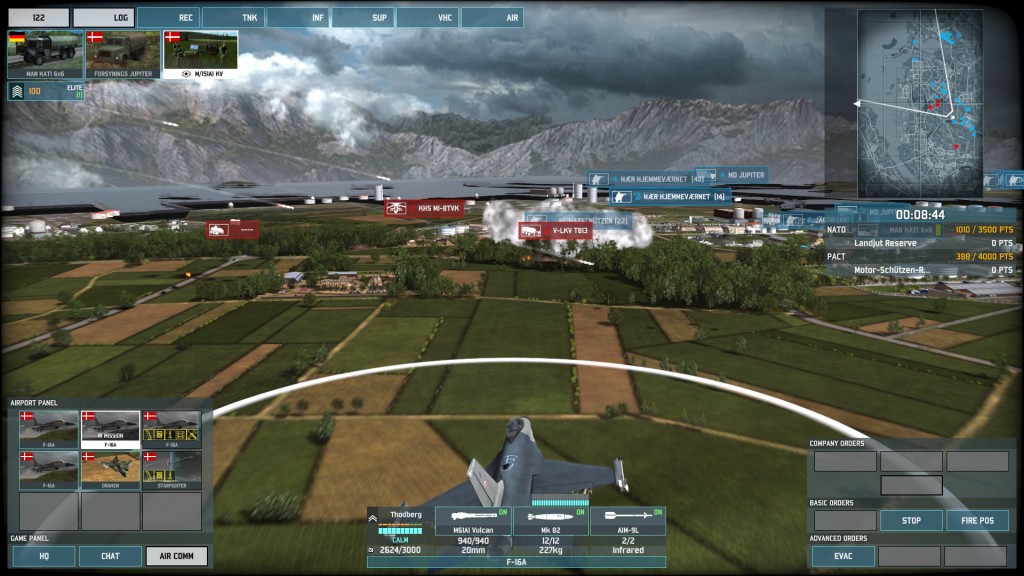




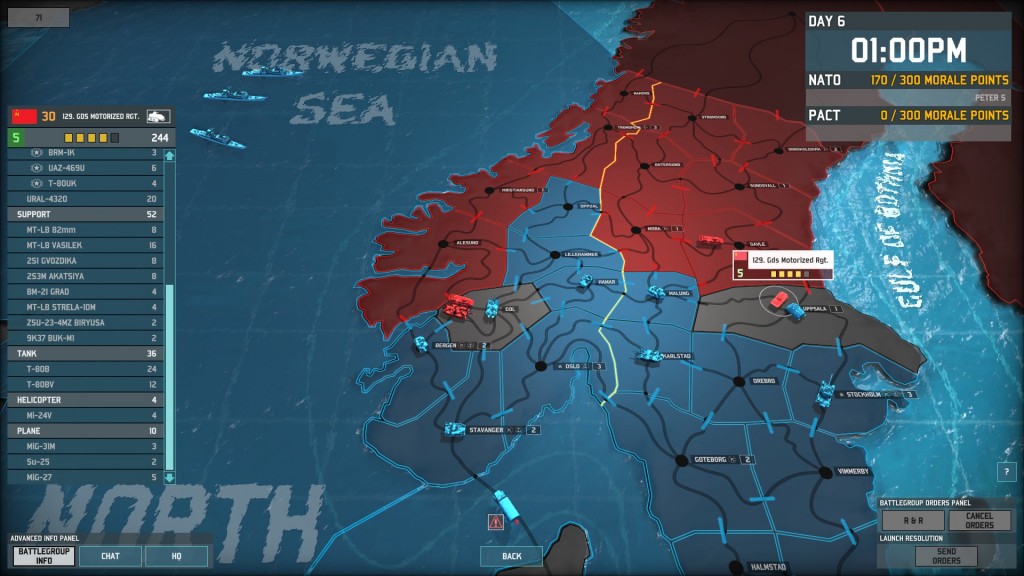
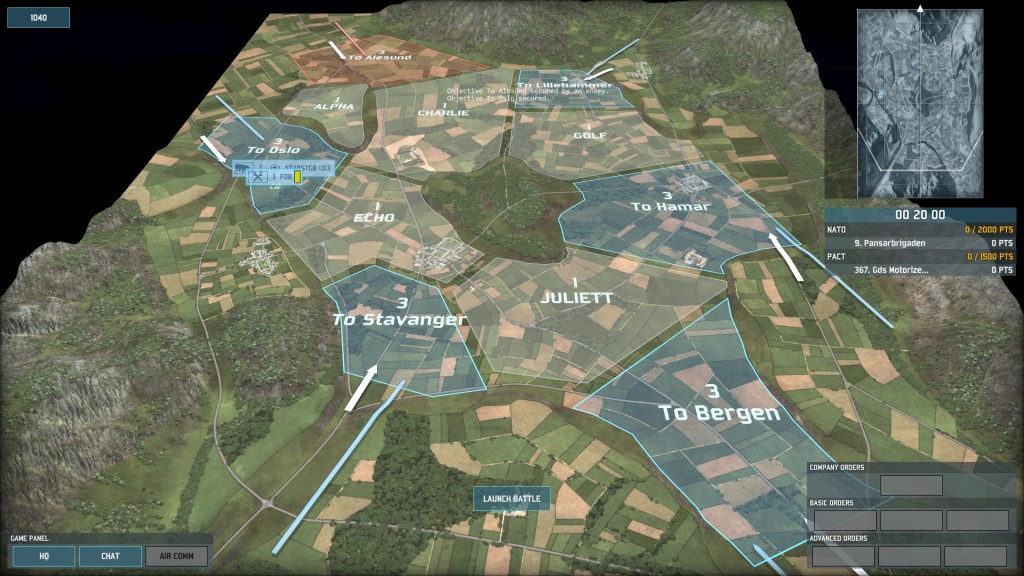













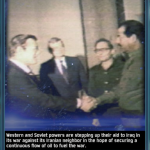




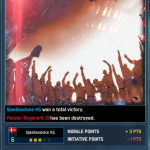












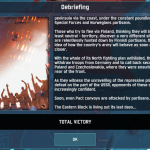

I never quite got the hang of the original W:EE, and I was kind of skeptical about AirLand Battle. But, having read your gripping LP and seen the campaign mode at work, I have to say it merits a second look.
Cheers and thanks for inviting us along for the ride.
Thanks, Ritalingamer! Glad you enjoyed it and found it useful.
Yeah, I gave up on W:EE’s campaign (it was the weakest part of the original by far), but the developers have shown a real willingness to learn from their mistakes — AB’s single-player is so, so much better than EE’s. I think AB is worth that second look, and if you do pick it up, hopefully you’ll find it more to your liking. :)
Hi!
I found this LP a fascinating read (wouldn’t mind another)! Your strategies are definitely much different than mine. The differences in thinking are what make strategy games so fascinating in the first place.
As writer of the linked guide there’s a couple things I’d like to comment on.
Engineering massive mismatches is essentially the whole game on strategic level. Holding ground is nice, but the game is mainly played for battlegroups. That’s what the original AirLand doctrine essentially proposes! Given a choice between taking Oslo and wiping out a battlegroup, I would almost always wipe out the battlegroup. Simply by existing a BG projects force on the map. It’s not just about what happens, it’s about what might happen. Same reason as why you’d want to anchor a knight in the middle of chessboard, instead of a corner.
I think the “eternal draw” is what defender wants. If you can use a weak battlegroup to indefinitely tie down a strong one, sap its initiative and pin it down, that is definitely a victory to you. Uncontrolled aggression is no good. It must be cold and calculated. Give the defender as few chances as possible to hold a draw. If you don’t fancy your chances nothing forces you to attack. You are better off preserving your fighting capability and concentrating your forces elsewhere. I also prefer to attack with two or more battlegroup if possible: that way, I lose one initiative per BG and enemy loses one initiative per battle. If you can afford bombing strikes before engaging, the enemy will be hard pressed to hold back your overwhelming numerical superiority against the last battlegroup.
As a final note, defending is hard. It’s much easier to hold forces in reserve and counterattack once the weak BG has taken the initial edge off. Think offensively!
Hi Hob! Great to see you here, and I’m glad you liked the LP!
Thanks again for the guide, and for your comments on the strategic level. I’m not sure our approaches to the campaign are that different after all! My overall plan for that campaign seems to be unique — NATO needs to buy time for its reinforcements to arrive, and I think most players try to achieve that by ordering the Norwegian Army to fight to the death, whereas I abandoned northern Norway/Sweden and made a run for the Bergen-Uppsala line. However, when it came to actually implementing that plan, I was absolutely religious about following the advice you & the others gave in that thread. I made very, very sure to position my battlegroups so that I could rush reinforcements to a threatened region (very useful in Aarhus, where I had 4 battlegroups cycling in and out of the province), and when it came time to counterattack, I deployed overwhelming force (3 battlegroups + an air raid at the schwerpunkt in Gol, plus I had spare air raids/deployable battlegroups waiting up my sleeve). I think I agree with every single statement you made about strategy!
As for future LPs, I think I am a little Wargamed out for now; but if you are a fan of Paradox games, I am probably going to write an LP of EU4 when that comes out in a couple of months’ time. Would love to see you around for that!
Wow, seriously that was badass man, I don’t think I could beat this on very hard difficulty take all the good paths you took. I really liked your let’s play, thanks for putting this up.
Thanks, Paul – I’m glad you liked it!
Great Report Peter
I bought this on Steam last week and so far have played the Training missions and have played through the first 3 campaigns – but I found the learning curve to be very steep and very little information on how to use units in the Campaign in game (plenty on the net such as yourself)
However I got rapidly unstuck on the final campaign making the mistake of trying to hold Norway and Sweden further North than you did.
I really did not understand the Initiative / Morale thing until I read your 2 articles and now that I have I am going to restart the campaign as repeating the “300” point vs 1500 point game was getting boring.
I was holding them off using cheap infantry holding choke points tactics (and retreating the APCs) but it was taking 20 minutes to get a large enough force together and most games were ending in a draw.
And I have a new found respect for the early T72 and Mobile AAA – especially against the Scandinavian 105mm L7 equipped tanks (M48, Centurion, Leo1 and S-Tanks) – during this period
Retreat – Rest and Refit
Thanks Jon – I’m glad you liked it & found it useful!
Yeah, the upgraded T-72s make the first (tutorial) Soviet campaign pretty easy. I think they’re immune to Swedish Centurion fire at maximum range.